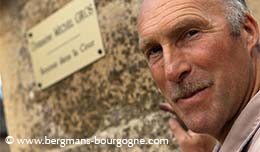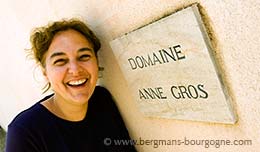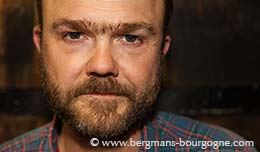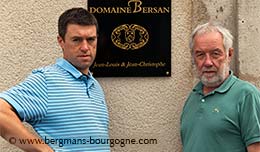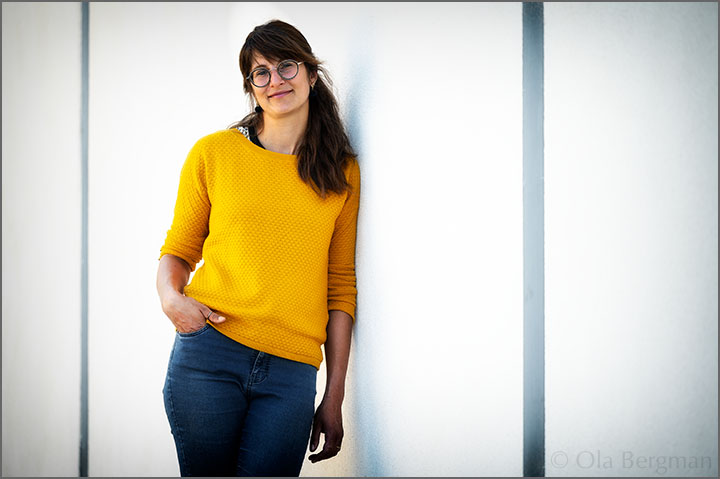
or Madeline Gay at Domaine Moë life is all about the Hautes–Côtes. Basically the whole domaine revolves around one single appellation – Bourgogne Hautes-Côtes de Nuits.
– My father decided to take all the plots of land the family had and plant vines in all of them, says Madeline Gay. This was right after his military service. He worked part-time for a winegrower in the village, where he also learned the job. He would take two days per week, plus the weekends, to plant his own vineyards.
Today Madeline Gay runs the domaine together with her husband Pierre. For several years she worked alongside her parents. Up until 2023 it was Domaine Yves Bazin Père et Fille. Then it became Domaine Moë.
– We chose the name Moë because it comes from Japanese slang and it describes the affection we have for the land, the Hautes–Côtes and for working together, says Madeline Gay.
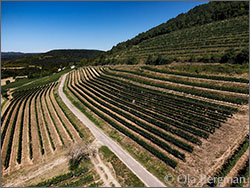 You’ll find the domaine in Villars-Fontaine, a village up behind Nuits-Saint-Georges with some 120 inhabitants. The origin of the domaine is similar to many others in the area. Madeline Gay’s grandparents were like most other people at the time. They did not rely on a single crop for their income. There were raspberries, blackcurrants and other berries. There were cows and there was a bit of wine, mainly for personal consumption.
You’ll find the domaine in Villars-Fontaine, a village up behind Nuits-Saint-Georges with some 120 inhabitants. The origin of the domaine is similar to many others in the area. Madeline Gay’s grandparents were like most other people at the time. They did not rely on a single crop for their income. There were raspberries, blackcurrants and other berries. There were cows and there was a bit of wine, mainly for personal consumption.
– My father was young when he started. 15-16 years old. He began planting in 1986 and in 1990 he was working full time for his own domaine. At this time my mother had joined him as well. They built the house. My mother would take care of the commercial side, while my father worked the vineyards and made the wine.
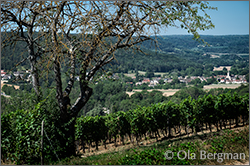 – Once the cows were gone they turned the cow shed at my grandparents’ house further down the road into a cuverie and a barrel cellar. Since then the domaine has grown slowly, step by step.
– Once the cows were gone they turned the cow shed at my grandparents’ house further down the road into a cuverie and a barrel cellar. Since then the domaine has grown slowly, step by step.
Madeline Gay arrived at the domaine in 2013. Her husband three years later. More vineyards were added in 2017 and a new building was built in order to house everything. Today they have close to 14 hectares.
– We only have Bourgogne Hautes-Côtes de Nuits, says Madeline Gay. About 60 per cent is red. Our vineyards are mainly here in Villars-Fontaine and in Segrois. There is a little bit in Villers-la-Faye, because my paternal grandmother grew up there.
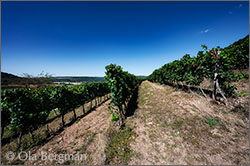 But for Madeline Gay the career choice was not obvious. Not to begin with at least.
But for Madeline Gay the career choice was not obvious. Not to begin with at least.
– No, she says. I was studying to become an accountant, something I enjoyed very much. I met my husband there. I ended it with a period as a trainee at a big accounting firm. The first year there I loved, but the second year it became tedious. It became very important how much time we spent on each client. The work was becoming repetitive and I felt stuck at the office. Weirdly enough I started missing the vineyards.
So she decided to give the life as winegrower a try. After six months she was sure. She got the appropriate education and joined her parents.
There are five Bourgogne Hautes-Côtes de Nuits cuvées at Domaine Moë. Two white – Origine and Alliance – and three red – Origine, Alliance and Ensemble.
 – For the white Origine the grapes come from three villages. Villers-la-Faye, Segrois and Villars-Fontaine. For the Origine cuvée old barrels are used in order to keep the fruity character of the wine and keep the character of the Hautes-Côtes.
– For the white Origine the grapes come from three villages. Villers-la-Faye, Segrois and Villars-Fontaine. For the Origine cuvée old barrels are used in order to keep the fruity character of the wine and keep the character of the Hautes-Côtes.
– The white Alliance cuvée is made with some new barrels, about 30 per cent, in order to bring a bit more structure to the wine. It comes from an old vines plot, which is better exposed. It’s in Villars-Fontaine as you go towards Concœur et Corboin. A very sunny place. We didn’t want to go all the way with all new oak. We are trying to use a bit of new oak in order to separate it from the other cuvée. Still, it has to be balanced. And with a white wine it can quickly become too much. I am trying to change it a little bit. Experimenting with other barrels. Trying to bring some finesse, bringing out the acidity of the wine.
On the red side the Origine and Allianace cuvées follow the same pattern as the whites. Only old barrels for the first and partly new oak for the latter.
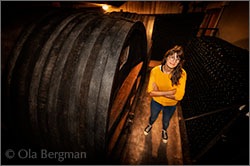 – The wines my dad liked were quite tannic, wines which could be kept for a long time. I prefer wines with a bit more finesse. We control the temperature in order to have fruitier wines. At the same time I try to keep the style of the domaine. I have been moving away from large wooden tanks. Instead I am using barrels for the élevage. For the red Alliance cuvée there is 60 per cent new oak. I am looking for length and finesse, not the oaky flavour.
– The wines my dad liked were quite tannic, wines which could be kept for a long time. I prefer wines with a bit more finesse. We control the temperature in order to have fruitier wines. At the same time I try to keep the style of the domaine. I have been moving away from large wooden tanks. Instead I am using barrels for the élevage. For the red Alliance cuvée there is 60 per cent new oak. I am looking for length and finesse, not the oaky flavour.
The Ensemble cuvée is a recent addition to the portfolio. It is only produced in years which favours the use of whole bunches.
In the Hautes-Côtes the vineyards often have a distinctly different look the ones further down on the Côte. The vines are trained higher and the rows are further apart. This is also the case at Domaine Moë, where all the vineyards are ”vignes hautes et larges”.
– It is more practical to work, says Madeline Gay. It also lowers the risk for frost damage, even if that is not always the case anymore.
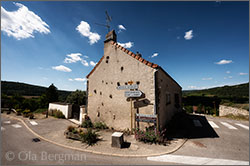 – I think it is because of the climate change. In the past there was often frost and it was because of that they started using higher training in the Hautes-Côtes. But the frost was usually earlier in the year and the buds were not as developed. In recent years it has been lovely weather in February-March. Everything start to grow and the sap rises. Already in March you can have buds bursting, so if you have a short period of low temperatures like 0°C to -5°C the buds are in danger.
– I think it is because of the climate change. In the past there was often frost and it was because of that they started using higher training in the Hautes-Côtes. But the frost was usually earlier in the year and the buds were not as developed. In recent years it has been lovely weather in February-March. Everything start to grow and the sap rises. Already in March you can have buds bursting, so if you have a short period of low temperatures like 0°C to -5°C the buds are in danger.
– Everyone has their own way of handling it. For haute et large vineyards the anti-frost candles will not work, because the vines are too far from each other. And personally I think burning hay will only add more to the problem. It is more about accepting and adapting. Stock up on wine in good years and put money to the side. There are things you have to accept, that nature is in control.
In the Hautes-Côtes de Nuits the majority of the vineyards have higher trained vines. Somewhere around 70-80 per cent. In the Hautes-Côtes de Beaune on the other hand lower trained vines are more common.
– I’m not sure why, says Madeline Gay, but in the Hautes-Côtes de Nuits there are many large domaines who do not produce any wine themselves. They deliver the grapes to the cooperative. They have many hectares and for them it is easier to work with higher trained vines.
– Some say that the lower trained vines produce a better wine, more concentrated. But I think the main difference is the winemaker.
Annual production at Domaine Moë is 40 000 bottles. Most of it is sold at the domaine. Some changes have already been made at the domaine, with the name change being the most obvious one.
– We do it little by little, says Madeline Gay. My father did things his way and if it has been working for 40 years it is really no reason to change it. But obviously I want to add my touch to the wines. I also want to understand the impact on the environment better. We have HVE (Haute Valeur Environnementale) certification since 2020. Things are slowly changing.
© 2025 Ola Bergman










